Capstone Holding Corp. lowers convertible note conversion price to $1.00
By Chibuike Oguh
NEW YORK, Aug 18 (Reuters) - Asian equities were mostly
firmer on Wednesday after a strong Wall Street session in which
the S&P 500 hit an all-time high, rebounding from huge losses
caused by the coronavirus pandemic.
Both the S&P 500 and Nasdaq Composite set records soon after
the opening bell following strong sales growth reported by major
U.S. retailers including Walmart, Kohl's and Home Depot.
The closely-watched S&P 500 topped an all-time peak reached
in February just before the onset of the COVID-19 pandemic drove
the benchmark index to lows on March 23. The index has surged
about 55% since then.
Market optimism was also buoyed by data showing an
acceleration in U.S. homebuilding to the most in nearly four
years in July, signifying that the housing sector is emerging as
one of the few areas of strength in an economy hit hard by the
pandemic.
"There was just this big focus on Home Deport doing great,
Walmart doing ok, Amazon adding jobs," said Hilary Kramer, chief
investment officer at Kramer Capital Research.
"What analysts didn't realise was that people were indoors
and did upgrades to their homes, combine that with bad weather
and people needing to buy things to stay at home - and they all
will still be at home."
Australia's S&P/ASX 200 .AXJO rose 0.1% in early trade
while South Korea's Kospi .KS11 was up 1.0%. Japan's Nikkei
225 .N225 slipped 0.2%.
Nasdaq clocked its 18th record closing high since early
June, when it confirmed its recovery from the coronavirus
sell-off. Tuesday's record was its 34th record close so far this
year compared with 31 record closing highs in 2019 and 29 in
2018.
Consumer discretionary .SPLRCD rose the most among major
S&P sectors on strength in Amazon while technology stocks
provided another major support to the benchmark index.
"We have this phenomenon where tech stocks and even Tesla
are just going up and while the rest of the market remains
fairly valued," Kramer said.
The U.S. Federal Reserve's intervention in financial markets
to maintain liquidity in the midst of the coronavirus pandemic
has weakened the dollar, pushed risk assets to all-time highs
and reduced demand for safe-havens. Minutes from the Fed's recent meeting due on Wednesday,
meanwhile, may provide some insight into how the central bank
sees the recovery playing out. The Fed has cut rates to near
zero to bolster business through the pandemic.
The dollar index =USD fell 0.551%, with the euro EUR= up
0.53% to $1.1932. The Japanese yen JPY= strengthened 0.60%
versus the greenback to 105.38 per dollar.
U.S. Treasury yields slid as the market largely snubbed the
strong housing data and looked for signs that a political
stalemate in Washington over a round of aid was easing.
The benchmark 10-year Treasury note US10YT=RR fell 1.8
basis points to yield 0.6655%.
Gold rose more than 1% to be back above the $2,000 level
breached earlier this month, as the dollar fell against a basket
of major currencies for a fifth consecutive trading day.
Spot gold prices XAU= rose 0.74% to $2,000.19 an ounce.
U.S. gold futures GCv1 settled up 0.7% at $2,013.10.
<^^^^^^^^^^^^^^^^^^^^^^^^^^^^^^^^^^^^^^^^^^^^^^^^^^^^^^^^^^^
Global assets http://tmsnrt.rs/2jvdmXl
Global currencies vs. dollar http://tmsnrt.rs/2egbfVh
Emerging markets http://tmsnrt.rs/2ihRugV
MSCI All Country Wolrd Index Market Cap http://tmsnrt.rs/2EmTD6j
^^^^^^^^^^^^^^^^^^^^^^^^^^^^^^^^^^^^^^^^^^^^^^^^^^^^^^^^^^^>
